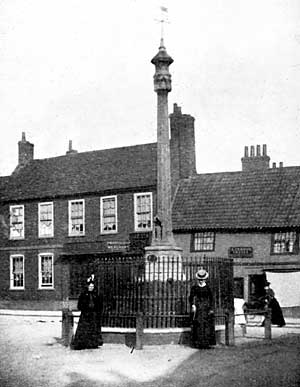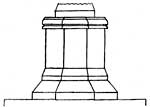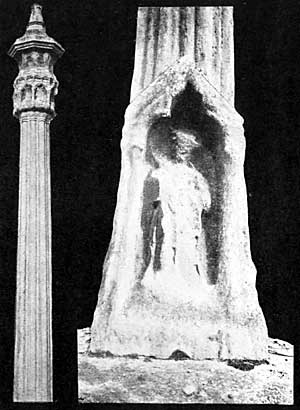The Beaumond-Cross, Newark, and its date.
By Mr. William Stevenson.

Plate I. Beaumond Cross, Newark.
THE above—as a heading of this article—might well be extended to read "a late 13th or early 14th century monument, that survived the town sieges during the Civil war, to be an object of profound interest in the 20th century, with photography as an aid brought to bear upon its probable or close date of erection."
It is a good and even an elaborate example of Edwardian English Gothic architecture, or when that art was at its best; this broad term dates from the first year of Edward I. (1272)—to the last of Edward III. (1377)—but in what part of that period it was erected is now only to be learnt by a close study of its details. This was not possible one hundred and forty one years ago, when a brass-plate recorded:—" Repaired and ornamented 1778, at the expence of Charles Mellish, Esquire, Recorder "; or one-hundred-and-eighteen years ago, when another brass plate was made to state:—"This cross, erected in the reign of Edward the Fourth (1461-1483), was repaired and beautified from the town estates A.D., MDCCCI.1" This Edward IV. date was singled out from time on the assumed evidence of a Lord Beaumont who was wrongly supposed to have been a local celebrity, and wrongly stated to have been killed at the battle of Towton Field, 1461. This error crept in from a desire to date the cross, with nothing but its popular name to work upon, which may only have been a descriptive one—"the fair-mount" of the ground thereabout. We first hear of the local name Beaumont in a deed dated 1310, and incidentally of the cross, itself in 13672 With the opening of the present century came the need of further repairs, which were carried out by the Corporation, who, not satisfied with the dating of the cross that had served for a century, sought the opinion of two members of a learned society; those gentlemen confirmed the general belief that the architectural details read back earlier: their opinion being to the reign of Edward III.— (1327 to 1377); the result of which is the present plate engraved—"This cross, erected in the reign of Edward III., was in the year 1903, by order of the Mayor and Corporation, cleaned and renovated, and the palisading renewed and refixed. James Skerret, Mayor; Godfrey Tallents, Town Clerk; George Sheppard, Borough Surveyor."3
This was certainly a move in the right direction. In 1904, appeared the first volume of "The History of Newark," by Cornelius Brown, which remains his best monument: at p. 75 the author quoted from my article on "The Death of Queen Eleanor of Castile," in 1290, that appeared in volume III of the Transactions of this Society, for 1899—four years before this latest brass-plate, in which I said I was strongly inclined to the view that the influence of the Bishop of Lincoln in Newark, had some relation to the so-called Beaumont cross. This could only mean that I ventured to date its erection 1294, or soon after, which is the date assigned, in the absence of a recorded one, to the beautiful cross at Geddington, Northants, (Parker's Glossary, Art. Canopy).
Mr. C. Brown, referring to this 1290 date, wrote:— "The Beaumond Cross cannot possibly be earlier than 1320, and is more probably of the second quarter of the 14th century,"4 giving as his proof the opinion of the authors of the brass-plate (1327-1377). He thus gives a more contracted date 1320-1350, or 1320-1348, if the "Black Death" is considered.
The question which I propound is this: can the cross, on a close study of its details, be dated earlier—say 1294-1299? These were the last five years of Bishop Oliver Sutton, of Lincoln, the Lord of Newark and its castle, who identified himself in London with the funeral of Queen Eleanor of Castile and built the Lincoln cloisters, whom I suspect of being the donor or builder of this as a devotional or memorial cross, with the one object—to which it was consecrated—tabernacled at its foot. Can we not here say, in the words of a modern writer,
"No image of some marble saint, Nich'd in cathedral aisles, is hallow'd more From the rude hand of sacrilegious wrong."
The death of Queen Eleanor late in 1290, would render it doubtful if anything further—than preparing designs for erecting crosses to her memory in towns and on roadsides—ensued in 1291. In 1292, and 1293, we have proof that her executors—not the king—were operating. No records extend to 1294, but such complimentary memorials may in certain places have been erected by the king, the bishops, or other great persons; what we are interested in is the fact that we have these 1292-3 details still with us at Northampton, and Waltham, for comparison, supplemented by the contemporary cloister work of Bishop Sutton, at Lincoln, and Archbishop John le Romeyne's part in the chapter-house at Southwell, 1286-1296.
There is a marked bishop's flavour and the designing hand of a goldsmith in this Beaumond Cross, as the design is based on such an ecclesiastic's crozier—a most fitting or natural thing to find in a bishop's town or manor; it has the round shaft, broadened out in the lower part for constructional reasons, and the elongated "knop," octagonal in plan, each facet wrought into a tabernacle occupied by a seated figure: some higher details remain, as shown in an illustration in Brown's History of Newark, Vol. i, p. 363, but they are of little service in restoring to our minds the original crowning finish of this still beautiful but timeworn monument.

Fig. I.—Details of base Block.
The base-block seen in Fig I. is octagonal in plan, 2ft. 10in, high, and about 2ft. broad; in itself it is a short column with sloping base or plinth, and moulded cap, the details (fig. 1.) read nearer to say 1240, than to 1290, this forms the table on which the cross or crozier stands and it is interesting to note what a firm grasp the latter has with its foot, a plain steep 13th century sloping base, to which the lower niche with its presumably crowned figure gives additional strength.
Ascending to the shaft we have an obelisk of exceptional interest, its sight-height is 12ft. 10in, but what more it goes down into the base-block, or up into the "knop" isnot known; its square at the bottom is 1ft. 41/2in., whilst the part forming the clustered-shaft is 1ft. 21/2in. diameter at its lowest part, and 101/2in. at its highest part; it is all on one solid block of oolitic "shell-limestone "from Lincoln Ancaster quarries; its state of preservation—considering its long exposure and highly wrought character—is remarkably good.

Plate II. Shaft of the Beaumond Cross, Newark.
Plate II. shows its lower part, a central shaft surrounded by a cluster of eight smaller ones interrupted by a niche on one side. This in block form is a characteristic feature of the arcade piers in the choir at Southwell. The date of construction 1230-1250, is given by Rev. J. F. Dymock in his great work (1853) on that minster;— (see illustrations—"Bell's Cathedral series" (Southwell) p. 70) still more elaborate and detached in Lincoln Angel-Choir, (same series p. 119) dated 1255-1280—the latter being the date of the opening of that extension when King Edward and Queen Eleanor were present. This Newark shaft when partly wrought would be a plain octagon with eight angles, these were retained and worked into ridges known as "keels," small details which give a pleasing effect. A variant and possibly earlier form was a "fillet," as is mostly the case at Southwell and Lincoln. To give a solid section a "boutel" was introduced between each pair of shafts; had the work antedated Edward I. this feature would have been elaborated into the well-known "dog-tooth" ornament, but in this latest phase of "Early English," alias "Geometrical Gothic," of Edward I, of which we have a fine example in the west front of Newstead priory, it had passed out of fashion.
(1) Annals of Newark, 1909, p. 19
(2) Ditto p. 72.
(3) Ditto
p. 363
(4) Ditto p. 76.
